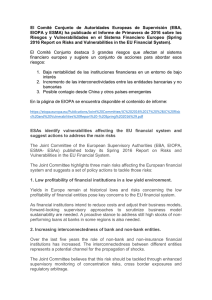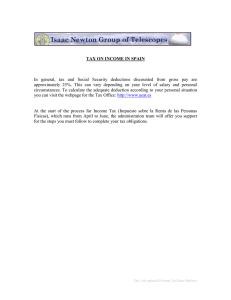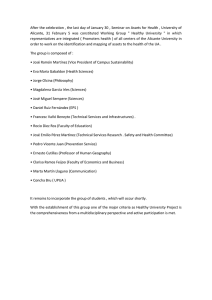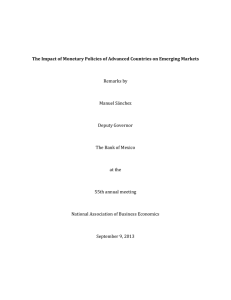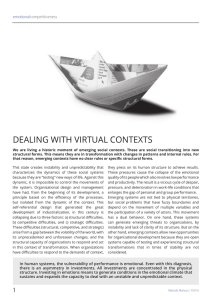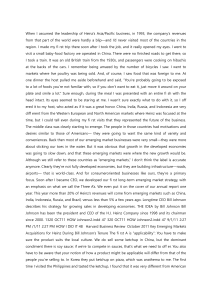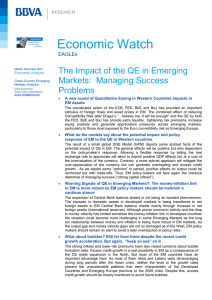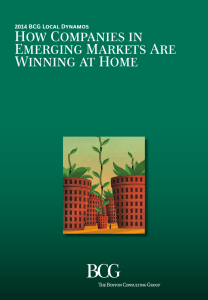Keys for the Analysis of International Markets
Anuncio
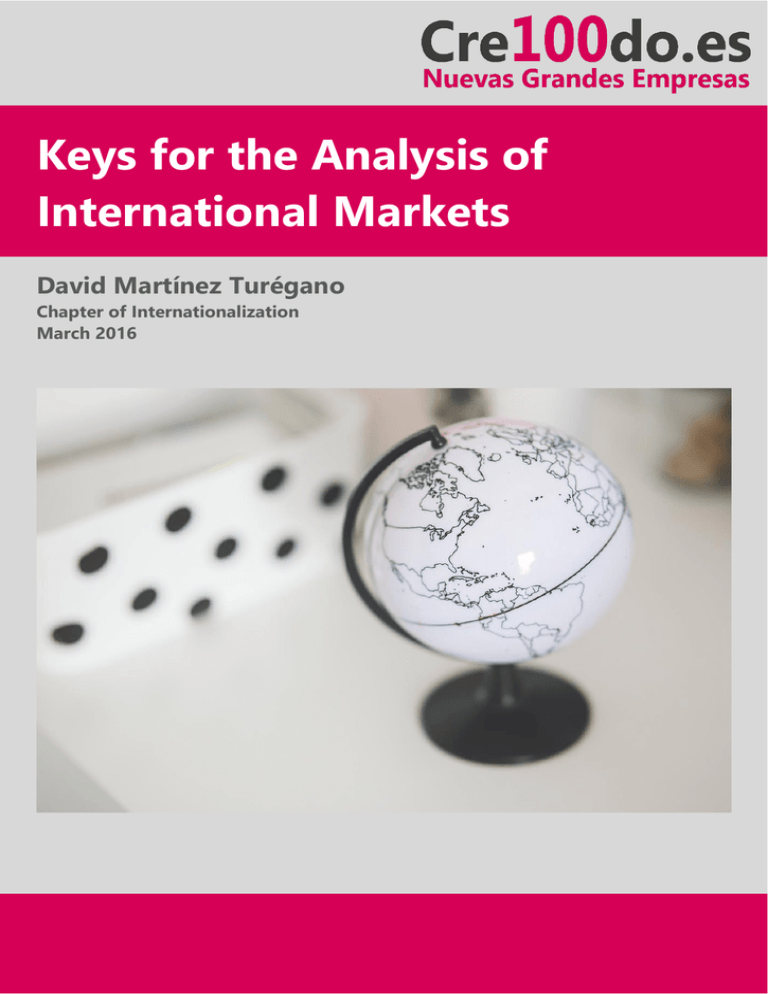
Keys for the Analysis of International Markets David Martínez Turégano Page1 Chapter of Internationalization March 2016 CLAVES DE ANÁLISIS DE MERCADOS INTERNACIONALES DAVID MARTÍNEZ TURÉGANO Index Author 1. Motivation…………………………………………………………..3 2. Great global transformations towards the 21st century…………………………………………………………………………….4 2a. A new (old) world order……………………………….4 2b. Towards another consumer profile…………….5 2c. Development of the productive fabric and competitiveness factors………………………………………7 2d. Impacts on demand: global industry of consumption, needs of investment and precision of “opportunity market” ………………………………..10 3. Synthesis of messages: final observation…………………. 15 David Martínez Turégano Senior Economist, Bank of Spain Cre100do Advisory Council Member [email protected] LinkedIn He holds a degree in Economic Science from the University of Castilla-La Mancha. M. Sc. in Economics and Finance from Centro de Estudios Monetarios y Financieros (CEMFI) of the Bank of Spain. He has thirteen years’ professional experience in macroeconomic analysis mostly in research departments at financial institutions, including six years in BBVA Research. He now belongs to the Euro Area and Monetary Policy Division of D. G. Economics and Statistics of the Bank of Spain. His speciality field is the analysis of international markets, particularly emerging economies, with a strategic focus. He has participated in research projects related to the impact of demographic changes, the expansion of middle classes, trends in international trade, determinants of economic inequality and analysis of growth risks in the medium and long term. KEYS FOR THE ANALYSIS OF INTERNATIONAL MARKETS Page2 This article is published as a paper of Cre100do publication series and is under a license Creative Commons type Attribution-NonCommercial-NoDerivatives 4.0 Spain. Thus this article can be copied, distributed and publicly communicated provided the authorship is acknowledged and it is not used for commercial purposes. For details of this license, visit http://creativecommons.org/licenses/by-nc-nd/4.0/. For any comment, you can write to: [email protected] DAVID MARTÍNEZ TURÉGANO “Everything flows and nothing abides”, Heraclitus “Everything which is ignored is despised”, Antonio Machado “If you already know what you have to do and you do not do it then you are worse off than before”, Confucius Key words International Markets, Emerging Economies, Structural Changes, Business Opportunities, Demographic Transition, Middle Classes, Cities and Urban Development, Competitiveness, Value Chains, Consumption Patterns, Investment Needs, Market Heterogeneity. 1. Motivation The decision to place a company’s product on the external markets sometimes means a turning point, both economically and culturally, for the company’s track record. It is a complex strategic challenge, but not more than others when one decides to exclusively develop the activity in the domestic market. Besides, risks are minimised and success probabilities increase if one has information and a rigorous analysis. Depending on the company’s motivation to go out, the selection of the target markets can be made in two ways: one decides to go out and sell in particular countries or one decides to go out and later select the countries. In any case, in both situations it is essential to have a notable knowledge of the opportunities and challenges involved in every country for the product which the company wants to sell. The analysis of these determining factors should lead a company to respond to two fundamental questions: 1. 2. What markets -in what countries and in what moment- meet our strategic objectives of profitability and risk? What is the best way to exploit these opportunities and efficiently face the challenges involved? In the elements which support the searching for an answer to these two questions one can distinguish aspects of the environment —economic, legal, social, political, cultural— which are shared by other companies and those more directly related to the company itself and to the activity sector, such as the productive processes and cost structure, or the competing companies. Having said this, the framework analysis proposed here should be complemented with more precise market studies which could give concrete responses to the idiosyncratic worries of any particular company. KEYS FOR THE ANALYSIS OF INTERNATIONAL MARKETS DAVID MARTÍNEZ TURÉGANO Page3 The purpose of this article is to present the great economic transformations which are taking place all over the world and value their implications for the global business development, singling out the countries and sectors which offer good opportunities for Spanish companies. An orientation is also added about what aspects should be considered to select the moment of penetration in the market and if this should be made as an exporter from the origin, from a third country or as a local producer. 2. Great global transformations towards the 21st century In the last quarter of the 20th century, the so-called emerging countries were associated with successive economic crises and episodes of financial instability, both political and social, which went across the world’s geography from Latin America to Southeast Asia going across East Europe. Business investments could be highly profitable in those markets, although they were subject to a significant amount of risk in contrast to a more conservative profile in mature markets such as advanced countries. The world economic panorama has greatly changed since the beginning of the 21st century. The emerging countries have taken into account the lessons of the crises experienced by themselves and have implemented a wide reform programme directed basically at the stabilization of their economies. At the same time, China, in the decade of the nineties, had been fostering significant structural transformations which would later place it as a new exporting power, condition which was ratified with its entrance into the World Trade Organization in 2001. The success of economic reforms in the emerging world, the irruption of China and a prolonged period of high prices of raw materials, whose main producers are developing countries, have prompted a change in the world economic paradigm in the last fifteen years. This new paradigm is marked by a lower risk associated to investment and the development of businesses in the emerging countries and it has enabled the explosion of their middle classes and a great improvement of their productive structures. These transformations have opened up new opportunities to companies in developed countries, such as Spain, which at the end of the most profound crisis in the last 80 years are facing perspectives of moderate growth and aging of their population. 2 a. A new (old) world order The emerging countries maintained relatively constant their weight in the worldwide economy all along the 20th century, accounting for around 40-45 % of the GDP. Current forecasts situate this percentage over 60% at the beginning of the next decade, in less than five years’ time. This participation in the world economy may sound extraordinary, but a more extensive historical revision identifies this anomaly precisely in the time lived between the industrial revolutions in the West and the beginning of the present century. It has just been in this period that today’s developed economies have had a prominent role in the economic activity, between the end of the Chinese and Mogul empires and the present new leadership of China and India. What seems really extraordinary is how quickly the emerging countries have reached their new condition of great economic powers and, much more under a historical viewpoint, the multiplier effect which this process has had on the global conditions of supply and demand, as will be seen in the following sections. From a geographical point of view, as it has already been noted, the emerging Southeast Asia is a clear leading figure of these transformations. Thus, this geographical region would account for more than 50% of the world’s economic growth which is expected to take place between 2000 and 2020. Given the starting size and the foreseen growths, China would contribute around 30%, India 10% and the rest of the countries the other 10%. This phenomenon has already led to a displacement of the world economic centre of gravity from the traditional Atlantic axis formed by the USA and Western Europe towards the Asia-Pacific zone1. Thus, if we take into account the emerging Southeast Asia together with the region’s developed countries2 and Latin America, the contribution would amount to three quarters of the expected world growth between 2000 and 2020. This relevance contrasts with the marginal contribution of developed Europe, equivalent or even surpassed by that of Africa, Eastern Asia or Emerging Europe. “EAGLEs Economic Outlook. Annual Report 2015”, BBVA Research, April 2015. https://www.bbvaresearch.com/en/publicaciones/eagleseconomic-outlook-annual-report-2015/ 2 The USA, Canada, Japan, South Korea, Taiwan, Hong Kong, Singapore, Australia and New Zealand. KEYS FOR THE ANALYSIS OF INTERNATIONAL MARKETS DAVID MARTÍNEZ TURÉGANO Page4 1 To be clear, if we want to search for economic growth in the coming years we should look at the emerging world, beyond the European frontiers, and, among developed countries, at the USA. 2 b. Towards another consumer profile The economic stabilization in the emerging countries has enabled a high and sustained growth from the start of the new century, exploiting the capacities and competitive advantages of a series of economies in a phase of development inferior to that of the developed countries. This positive evolution has underpinned highly significant profits in the population’s purchasing power, giving rise to an explosion of middle classes. This evolution is clearly a profound change in the perception of consumer demand in these countries, basically associated up to now to a more accelerated demographic growth and a population younger than in the developed world. The average consumer’s profile is experiencing in-depth transformations. undoubtedly In the demographic field, emerging countries retain a more expansive profile than advanced economies, although this general characterization becomes diluted if we consider the temporal dimension and the comparison between countries3. In this way, on the one hand, it must be noted that the population in the emerging world is “maturing”. The falling birth rate and the rising life expectancy have substantially increased the population’s average age, with a rising weight of the demographic segments of working age, with a greater consumption capacity. The decisive point of this situation is now taking place since, in the next decades, the segment of people aged 65 and more will gradually gain weight as ageing is a generalized phenomenon in the emerging countries. On the other hand, there are emerging countries which now present demographic structures similar to those of developed economies, with a working age population which is contracting; in particular, in Eastern Europe, but also in Thailand and China. In contrast, Latin America and India are in the transition to that point in the next decades, a long way away from the classical pyramid picture still prevailing in sub-Saharan Africa, with a wide base of young people. Among developed countries, the USA shows the least negative demographic profile, with a favourable migratory balance which supports greater growths of population —especially of working age— and a less marked ageing than in European countries or Japan. World population by age and sex (1990, 2010 and forecast for 2030) % of total world population 100+ Women Men 100+ Women Men 100+ 90-94 90-94 90-94 80-84 80-84 80-84 70-74 70-74 70-74 60-64 60-64 60-64 50-54 50-54 50-54 40-44 40-44 40-44 30-34 30-34 30-34 20-24 20-24 20-24 10-14 10-14 10-14 0-4 0-4 0-4 7 6 5 4 3 2 1 0 1 2 3 4 5 6 7 7 6 5 4 3 2 1 0 1 2 3 4 5 6 7 Women Men 7 6 5 4 3 2 1 0 1 2 3 4 5 6 7 Detailed information and previsions for countries are available in the United Nations: http://esa.un.org/unpd/wpp/ 3 KEYS FOR THE ANALYSIS OF INTERNATIONAL MARKETS DAVID MARTÍNEZ TURÉGANO Page5 Source: own elaboration from United Nations data (2012) As far as the population’s purchasing capacity is concerned, the estimates and previsions show that middle classes will account for two thirds of the world population in 2025, exceeding five thousand million people in this segment at the start of the 21st century4. The emerging countries have a central role in these dynamics, combining demographic growth with a rapid income transition of their population. income transitions are not expected among developed countries. In this way, a double significant change occurs for the consumer industry. The first one, already commented, is about volume. The second one is related to change forces of demand which affect products. In the year 2000, the middle classes with more purchasing power and the segment with a high income were basically constituted by citizens of developed countries. This situation will radically have changed in ten years’ time. In 2025 the majority of the population with a greater income will be residing in emerging countries, fundamentally in Asia and especially in China; India will probably live similar dynamics in 15 years’ time. In the early 1980s, 60% of the population was living in rural areas, situation which will have reversed in 2025, with three quarters of world urban population living in emerging countries5. It has also to be considered that this change in weight takes place in a context in which the world’s population is expected to surpass 8 billion people half way through the next decade, practically twice as high as in 1980. A third element which conditions the demand for consumption has to be added to demography and middle classes. It is the process of urban development and the leading role of cities in the world’s economic activity. In those developing countries where a middle class has traditionally existed —i.e. Latin America and Emerging Europe— it will be the segments with a higher income that will grow to a greater extent, while significant World population by GDP per capita (1980-2025) Billions of people 9 High Income Intermediate MC Low Income High Income Intermediate MC Low Income High Middle Class Low Middle Class 2025 2025 2020 2015 2010 2005 2000 1995 1990 1985 1980 0 2020 1 2015 2 2010 3 2005 4 2000 5 1995 6 1990 7 1985 8 1980 % of total world population 100% 90% 80% 70% 60% 50% 40% 30% 20% 10% 0% High Middle Class Low Middle Class Note: High Income corresponds to more than PPP-adjusted $40k, High Middle Class to $25-40k, Intermediate Middle Class to $15-25k, Low Middle Class to $5-15k and Low Income to less than $5k Source: BBVA Research (2015) “Flourishing Middle Classes in the Emerging World to keep Driving Reductions in Global Inequality”, BBVA Research, March 2015. https://www.bbvaresearch.com/en/publicaciones/flourishing-middleclasses-in-the-emerging-world-to-keep-driving-reductions-in-globalinequality/ KEYS FOR THE ANALYSIS OF INTERNATIONAL MARKETS Detailed information and previsions for countries are available in the United Nations: http://esa.un.org/unpd/wup/ 5 DAVID MARTÍNEZ TURÉGANO Page6 4 World urban population and large urban agglomerations by size (forecast for 2025) Urbanization rateUrban Percentage 0-25% 0-25% 25-50% 25-50% 50-75% 50-75% 75-100% 75-100% City population 1-5 million 5-10 million 10 million or more CityCity population population Urban 1-5 million 1-5 millionpeople 5-10 millions 5-10 million More than 10 10 million ormillions more Urban 0-25% Source: United Nations (2012) 25-50% 50-75% It is precisely in cities that activities 75-100% City population 1-5 million 5-10 million 10 million or more are concentrated in a country and big cities such as Tokyo or New York are similar to economies of the magnitude of Italy or Spain. Great cities in developed countries accounted for around one third of the world’s GDP in 2010 6. It is now emerging great cities that are taking the leading role of economic growth and it is estimated that they will explain half of the increase in global activity until 2025 and that Shanghai or Beijing will reach London, Paris or Los Angeles, with a GDP similar to those of Colombia or Thailand. Out of the nearly 40 mega-cities –i.e. cities of more than 10 million people- which are expected to exist in 2025, half of them will be situated in emerging Asia and only seven in the developed world. Thus, the new standard global consumer will be an urban citizen of an emerging country with a rising purchasing capacity, in many cases comparable to the average citizen of the developed world. 2 c. Development of the productive fabric and competitiveness factors The economic structure of a country evolves parallel to its development, due both to the consumer’s new profile of demand and new capacities of production units. Estimates for 2010 and previsions for 2025 in “Urban World: Mapping economic power of cities”, McKinsey, March 2011 6 KEYS FOR THE ANALYSIS OF INTERNATIONAL MARKETS As in the case of the consumption basket, a typical profile of the economic structure can be pictured in which the relevance of the agricultural sector gradually diminishes for low and medium income levels and remains minimally stable when the condition of developed country is obtained. On the other hand, industry has a rising role up to a medium-high income and it afterwards diminishes in a relatively rapid way, while the opposite occurs for services, with a strong tertiarisation process in high development phases. Emerging economies gradually acquire skills and knowledge to produce goods and services traditionally associated to the developed world. And this is not only to their advantage when they compete directly with companies of advanced countries but also, from the opportunity viewpoint, are constituted in a good potential destiny for a company to decide to set up closer to their end customer. The sophistication level of the productive fabric advances hand in hand with economic development and South Korea is a good example. In the 1960s, with a per capita income equal to that of its northern neighbour, exports were mainly agricultural, primary products without elaboration. In the early 1980s, when it had an income level similar to that of China today, produced and sold abroad manufactures of low technological content, such as textiles and metal products. Finally, nowadays, it has become an advanced country and the main source of exporting revenues comes from technological industries, DAVID MARTÍNEZ TURÉGANO Page7 Percentage (megacities) such as automobiles, ships and optical instruments, or electronic and telecommunications equipment. Therefore, the evolution of labour costs (and production costs in general) with regard to productivity levels must be monitored. And this evolution, shifted over time a 20-30 year period, is now occurring in China, which has gradually become since the end of the 20th century the world’s factory in sectors of highly diverse technological intensity. On the other hand, as a country develops and wages of the productive structure grow, other costs take more relevance, such as those related to transport of the product to the target market. Thus, the reflection on competitive sources similarly undergoes a kind of revolution too. Good examples of this are the cases of China and Mexico, with productive structures which present significant similarities and which have the large North American market among their objectives. The labour cost per hour in the manufacturing sector was three times as high in Mexico as in China in 2010, and this fact more than compensated the clear advantage of localization of the former country regarding the USA. Nevertheless, for some years wages in China have grown exponentially and could be comparable to those in Mexico in the coming years, reversing the sign of competitive advantage towards a third country. Thus, we have seen a rising interest of Asian companies in installing in Mexico in order to exploit an environment of moderate wage increases and nearness to the destination consumer. A good example is the automobile sector. Still today, low labour costs are a focus of attraction for the activity of foreign firms in emerging countries 7, but, as the per capita income gets closer to that of developed countries, this competitiveness factor is diluted and other dimensions take relevance. On the one hand, the productivity levels of this cheaper production structure are to be taken into account as the cost per unit of product may be more elevated in emerging countries. This can be compensated via margins by selling the product outside the production place provided that the target market has a higher purchasing power. As a country develops and its income level increases its capacity to “hide” its productivity gaps is reduced, probably resulting in a relocation of production. Hourly labor compensation in the manufacturing sector (2000-2013) USD at market exchange rates USD at 2013 constant market exchange rates 12 2013 2012 2011 2010 2009 2008 2007 2006 2013 2012 2011 2010 2009 2008 2007 2006 2005 0 2004 0 2003 2 2002 2 2001 4 2000 4 2005 6 2004 6 8 2003 8 10 2001 10 Brazil Poland Mexico China Philippines India 2002 Brazil Poland Mexico China Philippines India 2000 12 Source: own elaboration from The Conference Board data (2014) An international comparison of labour costs per hour in the manufacturing sector is available at The Conference Board of the USA: https://www.conference-board.org/ilcprogram/#Compensation KEYS FOR THE ANALYSIS OF INTERNATIONAL MARKETS Page8 7 DAVID MARTÍNEZ TURÉGANO Hourly labor compensation in the manufacturing sector (2013) USD at market exchange rates 70 60 50 40 30 20 10 Norway Switzerland Belgium Sweden Denmark Germany Australia Finland Austria France Netherlands Ireland Italy US Canada UK Japan Spain N.Zealand Singapore Israel South Korea Argentina Greece Portugal Slovakia Czech Rep. Estonia Brazil Hungary Taiwan Poland Mexico China (2012) Philippines India (2011) 0 Source: The Conference Board (2014) A good analysis of these factors can be read in the annual report on global competitiveness elaborated by World Economic Forum, which evaluates the different dimensions through surveys and indicators8. The analysed dimensions, of a great impact on the ability to do business in a country, cover the institutional framework, the infrastructure network, the macroeconomic environment, the educational and formative levels, the efficiency in the functioning in goods and labour markets, the development of the financial system, the technological disposition, the sophistication of businesses and the innovative capability. These dimensions will be more or less relevant according to the sector in which the company operates as well as the organization, the abilities and the knowledge of the own company. Moreover, one cannot stop at the first level of analysis, as the firm and the sector do not operate by themselves, either locally or globally. For instance, the availability of skilled labour in a country will be important if a company The latest issue available can be read on: http://reports.weforum.org/global-competitiveness-report-2015-2016/ 8 KEYS FOR THE ANALYSIS OF INTERNATIONAL MARKETS which requires this type of resources is evaluating its settlement in such a market and its policy is to employ local personnel, but not directly if what it wants is to export there or develop the activity with expatriates exclusively. However, even in this situation, indirectly, the existence of skilled labour can be relevant if the activity sector is related in its value change to another one which requires it, or if suppliers are from a third country; it will be in that country that the availability of skilled labour will have to be checked. The derivatives presented in this example clearly indicate the need to make a good joint assessment of competitiveness factors, taking into account the maximum possible number of interactions with other agents and markets. In the same vein, the early detection of possible bottlenecks in the production and sale chains can be the foundation for the success or failure of internationalization. The existence of bottlenecks is more frequent in emerging countries, although it is not their exclusivity. A good example is constituted by the growth difficulties experimented by developed countries at the end of the great recession initiated in 2008, particularly some European countries with a high indebtedness, both private and public, which limits the granting of new credits and the spending capability of households and companies as well as structural problems which diminish DAVID MARTÍNEZ TURÉGANO Page9 More generally, beyond labour and transport costs, the competitive factors of any economy are very diverse and must be taken into account when selecting the market where a firm wants to sell its produce, either as an exporter or as a local producer. As for emerging countries, the challenges they face differ greatly from one another, depending mainly on their income level. It is important to remember that each development phase entails a series of opportunities, but also of challenges. The virtue is found in keeping in step the improvement of the population’s purchasing power with the generation of new productive foundations for the country. Very frequently the way towards that virtue has been interrupted by the easiness to make demand policies with a favourable external environment (such as a high fiscal expenditure or low exchange rates) which promote the rising of income in the short term, as against the difficulties and efforts which supply policies involve (such as increasing the efficiency and agility of public administration or developing an innovation system), with returns to welfare in the short and long terms. The countries which do not succeed fall into the so-called “income traps”, that is to say, their inability to jump into a superior stage of development. Nowadays, after a continuous period of high growth, many emerging countries are in the dilemma of encouraging reforms or taking a step backwards, breaking the expectations placed on those markets. In this way, the reform programmes adopted by Mexico and India must be welcomed as well as the measures adopted by China for a change of economic model towards a lesser but more sustainable growth. Peru and Colombia must also be mentioned positively here, as they show a business environment similar to that of Spain, with a quite lower per capita income9; a similar situation is observed for Indonesia, Malaysia and Thailand in global terms of competitiveness10. In contrast, countries equally with a great potential, such as Brazil and Turkey, are finding more difficulties to implement a positive structural change of their economies. The latest complete list of countries according the easiness index to do businesses of the World Bank can be consulted at: http://www.doingbusiness.org/rankings 10 The latest complete list of countries according the global index of competitiveness can be consulted at: http://reports.weforum.org/global-competitiveness-report-20152016/competitiveness-rankings/ 9 KEYS FOR THE ANALYSIS OF INTERNATIONAL MARKETS Among great developed economies, the USA stands out, with high efficiency levels of its markets and a notable human and technological capital. 2 d. Impacts on demand Global industry of consumption Processes of demographic “maturity”, middle classes and urban developments do not only entail the expansion of the demand basis of emerging consumption in quantitative terms, but also these phenomena introduce significant changes into the consumption basket. Low income families assign a high percentage of their income to the acquisition of basic products such as food, clothing and footwear, which is gradually reduced as purchasing capacity grows. Families increase then progressively expenditures on the so-called discretionary products such as transport, electrical appliances, communications, entertainment equipment, restaurants, tourism, personal care or financial services, and those families with a higher income generate space for the luxury goods industry. This same pattern can be replicated for countries with respect to the explosion of the middle classes11. South Korea again is a good example, as it has experienced an outstanding development in a relatively short period, from being a mainly agricultural economy in the 1960s, with subsistence consumption levels, to being a world technological power with GDP per capita levels of a developed market. During this transition, households’ expenditure percentage destined to basic products diminished from nearly 40% in 1980 to less than 20% in 2010, while discretionary expenditure increased from 40% to nearly 60% in the same period. Therefore, there is a direct connection between income level and consumer habits which can be transferred to the business context and activity sector of every company through the so-called product penetration curves. This element of analysis is undoubtedly crucial for assessing and getting to know where and when a significant growth of the demand for a particular product is expected. 11 Page10 their ability to increase their production under the ageing of their population. See footnote 2 DAVID MARTÍNEZ TURÉGANO Consumption basket in South Korea (1980-2010) % 60 90% 55 80% 50 70% 45 60% 40 50% 35 40% 30 30% 25 20% 20 10% 15 0% Low Income Discretionary Interm. Income Semi-necessities 56 40 37 27 24 17 10 High Income 1980 Discretionary Basic products 1990 2000 Semi-necessities 2010 Basic products Note: Basic Products refer to Food, Clothes and Footwear, Semi-Necessities to Housing, Equipment and Health, Note: Basic Products refer to Food, Clothes and Footwear, Semi-Necessities to Housing, Equipment and and Discretionary Expenditure to Transport, Communications, Leisure, Restaurants, Hotels, Personal Care and Insurance Health, and Expenditure to Transport, Communications, Leisure, Restaurants, Hotels, Personal Care, Insurance Source: BBVA Research (2013) Source: BBVA Research (2013) The main handicap of this instrument is the common absence of data, especially when the spotlight is put on very concrete products, which is why it will be companies with a traditional presence in foreign markets that will take advantage of their own information to make previsions or extrapolate trends to other markets. Thus, for instance, in the automobile sector, the available estimations12 show that the number of cars per capita grows slowly at first up to medium levels of development, increases its expansion in a significant way and is stabilised when a country reaches advanced standards. in Europe or Colombia in Latin America, as against what happens in more mature emerging countries like Poland or in developed countries, where the great majority of sales corresponds to the renewal of the existent fleet — which, in any case, means an attractive business for the most dynamic advanced economies like the USA. A good example of this pattern is China, where up to the year 2000 the automobile ratio did not reach 10 units per 1,000 inhabitants and had a car fleet inferior to that of Spain with a very superior population volume (9 million as against 17 million cars, respectively). As a result of China’s transition to being a country with a medium income and high growth rates, previsions say that the ratio of car possession will be over 150 units per 1,000 inhabitants in 2020, for a total car fleet superior to 200 million vehicles. This would happen, for instance, with electrical appliances, since, according to a study by McKinsey13, the highest acceleration in the demand for refrigerators would take place on the low income levels and a saturation level per capita would soon be reached, whereas the selling of washing machines would be more progressive as the purchasing level rises. With these parameters, and in a similar way, notable increases of car fleets are expected in the coming years in the majority of countries in South Asia (with a foreseen explosion for India in 15 years’ time), in Turkey “Emerging Markets Key for the Automobile Sector”, BBVA Research, October 2012. https://www.bbvaresearch.com/KETD/fbin/mult/121010_EAGLEs_AutoPr ojections_EN_tcm348-359255.pdf 12 KEYS FOR THE ANALYSIS OF INTERNATIONAL MARKETS It must be emphasized that having penetration curves for every product is very important, as their stages of low growth, explosion and stabilization can occur in completely different times and intensities, even within the same sector. An additional element with an impact on the consumption industry which is worth stressing is the reduction of households’ size which is caused by economic development and that it would compensate the lesser growth of the population in the emerging world in terms of family units of consumption, which, after all, will be the relevant ones for industries of “Urban World: cities and the rise of the consuming class”, McKinsey, June 2012. http://www.mckinsey.com/insights/urbanization/urban_world_cities_and _the_rise_of_the_consuming_class 13 DAVID MARTÍNEZ TURÉGANO Page11 Consumption basket (CPI weights) (2012) Average according to GDP per capita 100% durable consumption goods like electrical appliances or automobiles. transport equipment, industrial facilities, offices and infrastructures. Finally, in the developed countries it is important to highlight that, although there is not a significant income transition or changes associated to it in the consumption basket, there are trends that are worth being followed. The first one is the ageing of the population, as the elderly, with a rising weight, present a very different spending pattern from the adult population, with a lesser assignation, for instance, to durable consumption goods14. The second one is the change in the habits of the new generations of consumers, the so-called millennials, that is to say, those born in the 1980s and early 1990s, with a greater tendency to share consumption or use the new technologies15. For instance, in the area of infrastructures, estimations made by the World Bank situate the needs in the emerging economies in some 850 million dollars annually up to 203016, including sanitation, conservation and channelling of water, transport, electricity and communications. The majority of these investment works are being generated in Asia, given the population volume and the economic growth, but they are also significant in Latin America or sub-Saharan Africa. Needs of investment The development of emerging economies is not only having a global transcendence in the consumer industry; very relevant changes and impacts are occurring in the productive area and in the demand for investment goods, both in volume and composition. The generation of an industrial basis first, the posterior sophistication of the productive fabric and the switch to a service economy gradually condition investment needs, which are progressively being adjusted to the new consumption profile as well. Let us take the case of China as an illustrative example. In the middle 1990s, capital stock was concentrated (around 75%) in the hands of the construction sector, industries of basic products (raw materials and manufactures of low technological content) and public services. Fifteen years later, the weight of the capital stock of private services, networks (of supply, transport and communications) and industries of technological content, both medium and high, had grown over 40%, reflecting the enormous productive developments of the Chinese economy. But for this positive scenario to take place, the converging of economic and financial stability is needed, as well as private initiative and reform impulses, not forgetting the need for each company to make a multidimensional analysis of markets. An attractive additional sector within investment is housing, both because of demand needs and the problems and shortages which this sector has in many emergent economies. As far as demand is concerned, demography is still expansive and the reduction effect of household’s size is also favourable to compensate the expected lesser growth of population. Besides demographic factors, the greater level of urban development and the higher purchasing power will sustain the demand for housing in the future, with an impulse of the segment of greater quality and price because of the middle classes’ explosion. Thus, in general terms, the economic dynamism which is expected in the emerging world for the coming years backs important growths of investment in machinery, As for the repercussions of ageing on consumption in Spain a special box could be read in the Consumption Outlook of BBVA Research, Second Half 2013: www.bbvaresearch.com/publicaciones/situacion-consumo-segundosemestre-2013/ (in Spanish) 15 www.goldmansachs.com/our-thinking/pages/millennials/ 14 KEYS FOR THE ANALYSIS OF INTERNATIONAL MARKETS “Capital for the Future: Saving and Investment in an Interdependent World”, World Bank 2013: http://siteresources.worldbank.org/EXTDECPROSPECTS/Resources/4768 82-1368197310537/CapitalForTheFuture.pdf DAVID MARTÍNEZ TURÉGANO Page12 16 GDP per capita (2014) USD 25000 Market exchange rates PPP-adjusted 20000 15000 10000 5000 Russia Brazil Malaysia Mexico Turkey Colombia China Peru Indonesia Philippines India 0 Source: IMF (2015) Precision of “opportunity market” The traditional approach of analysis and selection of markets has as a reference unit the economy of a country. Nevertheless, territorial heterogeneity can reach levels equivalent to differences between countries. Thus, taking as a reference the variable GDP per capita, the states in northern Mexico and those situated in the Yucatan Peninsula have a very superior income to that registered in the southeast area of the country. And something similar occurs between the coastal Chinese provinces and the inland ones, or between the western See, for example, “Room for Development: Housing Markets in Latin America and the Caribbean”, IADB, April 2012. http://www.iadb.org/en/research-and-data/dia-development-in-theamericas-idb-flagship-publication,3185.html?id=2012 17 KEYS FOR THE ANALYSIS OF INTERNATIONAL MARKETS states in India and the central and eastern inland ones. This heterogeneity ought not to be alien to developed countries, with comparable income differences between north and south in Italy and Spain, or between coastal and southeast states in the USA. The diversity picture inferred from these data implies that it is necessary to use the same criteria of analysis which is used to approach a “country-market” and to take into account the importance of the level of economic development seen in previous paragraphs for the course of consumption demand or productive capability and competitiveness, as well as the need to analyse the whole value chain beyond a concrete market of final demand. Let us consider, for instance, a country which has a great city with a high purchasing power because it is a finance centre, while the rest of the territory, heavily populated, has a subsistence economy. The average income of the country would be an erroneous indicator to measure the real potential of the mentioned market, as we are actually facing a polarised income structure. Once this problem has been solved and the great city has been identified as a genuine market for the company because of its high income per capita, the complete analysis would indicate that the only way of access could be export, as the bases for implementation as a local producer do not exist, because of lack of both a supplying industrial fabric and infrastructure to take the product to the end customer. DAVID MARTÍNEZ TURÉGANO Page13 When assessing investment projects in housing, the problems and shortages of this sector will also have to be considered as challenges and opportunities. These problems and shortages concentrate in urban areas and include the lack of basic infrastructures, finance access of families, informal settlements, low quality of materials, insecurity problems and overcrowding17. Public policies have therefore a crucial relevance when determining the projects in this field and are complementary to private initiative, particularly in the provision of sanitation, drinking water, transport, lighting, security, social services, healthcare and family and education services. In addition to this key factor of territorial heterogeneity, a second relevant element in the definition of “opportunity market” of a company, especially in the consumption sector, is the correct measurement of the purchasing power of the population. The information on the per capita income in the sources of every country is ordinarily available in local currency only, which does not allow making international comparisons, and the value of the mentioned income is of no use to assess internationalization options. International organisms, such as the International Monetary Fund or the World Bank, also present data in units comparable between countries, usually in American dollars, which allows an approximation to relative differences between markets. However, these figures also present a drawback, which consists in the existence of very different prices in various countries which may not be reflected in exchange rates into which the per capita income in local currency is transformed. These differences can be corrected by adjusting values through purchasing parity. Therefore, the exporting company is conditioned to a greater extent by exchange rate variations. In contrast, the firm which produces locally, and for the local market, is more interested in getting to know the population’s purchasing power in terms of the products which they can acquire. In this case, the relevant variable will be the revenues adjusted through purchasing parity, related to a greater extent to domestic development and growth. Returning to the previous example, let us suppose that a company commercialises a product at a domestic price of 12,000 dollars; if this product were exported to Mexico at a cost of the producing country, this would leave the average consumer out of its demand (10,000 dollars), whereas if it decided to settle to produce locally at a local cost, the average income (18,000 dollars) would greatly exceed the price of the product, generating a larger consumption base. The benefits of information in each of these transformations are better understood with an example. The average income per capita in Mexico is estimated at around 150,000 Mexican pesos, level which cannot be valued unless we live in that country and compare it with our revenues and expenditures. If we apply the exchange rate in effect, this value is converted into somewhat more than 10,000 dollars, which we compare with 26,500 dollars for Spain or 81,000 dollars for Norway. Nevertheless, prices of products in Mexico are lower than those in these two countries, which is why we value the Mexican consumption basket at US dollar prices, which results in an average income of more than 18,000 dollars adjusted through purchasing parity, some 80% more than measured in exchange rates, comparing this now with 35,000 dollars for Spain or 67,000 dollars for Norway18. The distinction is important as the use of one or the other definition will depend on whether the company is oriented towards export or multi-localization. Page14 For an exporting company it is relevant to know the population’s capability of international purchasing, that is to say, which global consumers have the necessary revenues in dollars to evaluate the purchase of a product. Compared estimations for 2015 of every country can be seen in the data basis of the IMF: http://bit.ly/1VvNIu0 18 KEYS FOR THE ANALYSIS OF INTERNATIONAL MARKETS DAVID MARTÍNEZ TURÉGANO 3. Synthesis of messages Final observations In this report we have intended to underline the great transformations which are being produced in the world’s economy and particularly the opportunities which these developments are already offering to Spanish companies for the settlement or extension of businesses in foreign countries. The driving factor of these changes is the rising leading role of emerging countries, not only with a high growth —differently superior to that of developed countries— but also with a constantly growing weight in the definition of trends in global markets. It is difficult to synthesize in a few pages the impact of the present global economic developments of business activity. Also within the investment industry, in addition to a more elevated growth horizon, relevant global trends driven by emerging countries are identified, such as a greater productive capability of companies and a more prominent sophistication of the economic fabric in these markets. In this context, attractive growth opportunities for investment in machinery, transport equipment, industry installations, offices and infrastructure are being generated; and, as far as households are concerned, also in housing. As for markets which will be of greater interest in the coming years, the area of emerging Asia stands out over the others, with China and India leading the way, well supported by the ASEAN countries, all of them driven by the generation of large middle classes, while in Latin America our look must be set on the promising future of Mexico and, with a lower market dimension, Colombia and Peru. Among the developed countries, the USA shows an advantageous position in the demographic and competitive fields compared to that of Japan or European economies. Secondly, this diagnosis about the need for knowledge is all the more evident in view of the transformations which are taking place. The change of paradigm in emerging countries implies to get away from the comfort of mature markets and look at countries with enormous dynamism which continually transform their consumers’ profiles, their productive structures and their competitive factors. In the case of Spain, in view of the difficult domestic situation, a virtue should be made out of necessity in order to implement business projects which are well worth it19. In the third place, these changes in our usual thought places demand a great deal of preparation, willingness to change and ability to adjust to new profiles of customers and markets. Strategic decisions, commercial policies, logistic organization and other managing aspects of a company involve the necessary human capital. A fourth and last message, reiterated through the previous pages, is the heterogeneity of markets, both geographically and temporarily, which means that “good businesses” for every product may present themselves in different places and times. Anticipating these dynamics may mean the decisive advantage over the competition, but always with a clear question in mind: what each company is aiming at. “España está en crisis, el mundo no”, Josu Ugarte (2013), Ediciones Gestión 2.000 19 KEYS FOR THE ANALYSIS OF INTERNATIONAL MARKETS DAVID MARTÍNEZ TURÉGANO Page15 In the consumption industry, the population’s growth in emerging countries is still a supporting factor but its importance has diminished in the last years and this tendency will continue in the coming decades. On the contrary, the boom of middle classes is primarily taking over, being localized in urban areas, with greater purchasing power and substantial changes associated in the consumption basket, while in developed countries variations in expenditure habits more related to the age of consumers, ageing of the population and the role of millennials are also taking place. And it is complicated because, as a first general highlight, it is essential to avoid simple tools and comparisons when international markets are analysed. A company must address its potential opportunities from sound knowledge and a multidisciplinary and transversal vision, as many are the factors which are to be taken into account. In this respect, a challenge may be an opportunity and vice versa.
